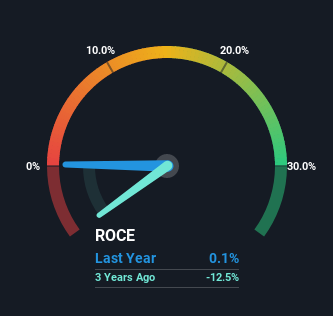Synex Renewable Energy (TSE:SXI) May Have Issues Allocating Its Capital
To avoid investing in a business that's in decline, there's a few financial metrics that can provide early indications of aging. Businesses in decline often have two underlying trends, firstly, a declining return on capital employed (ROCE) and a declining base of capital employed. This indicates the company is producing less profit from its investments and its total assets are decreasing. On that note, looking into Synex Renewable Energy (TSE:SXI), we weren't too upbeat about how things were going.
Return On Capital Employed (ROCE): What Is It?
For those that aren't sure what ROCE is, it measures the amount of pre-tax profits a company can generate from the capital employed in its business. The formula for this calculation on Synex Renewable Energy is:
Return on Capital Employed = Earnings Before Interest and Tax (EBIT) ÷ (Total Assets - Current Liabilities)
0.0014 = CA$28k ÷ (CA$22m - CA$1.7m) (Based on the trailing twelve months to June 2022).
Thus, Synex Renewable Energy has an ROCE of 0.1%. Ultimately, that's a low return and it under-performs the Renewable Energy industry average of 3.9%.
See our latest analysis for Synex Renewable Energy
Historical performance is a great place to start when researching a stock so above you can see the gauge for Synex Renewable Energy's ROCE against it's prior returns. If you want to delve into the historical earnings, revenue and cash flow of Synex Renewable Energy, check out these free graphs here.
What The Trend Of ROCE Can Tell Us
The trend of ROCE at Synex Renewable Energy is showing some signs of weakness. The company used to generate 2.3% on its capital five years ago but it has since fallen noticeably. What's equally concerning is that the amount of capital deployed in the business has shrunk by 37% over that same period. The combination of lower ROCE and less capital employed can indicate that a business is likely to be facing some competitive headwinds or seeing an erosion to its moat. Typically businesses that exhibit these characteristics aren't the ones that tend to multiply over the long term, because statistically speaking, they've already gone through the growth phase of their life cycle.
What We Can Learn From Synex Renewable Energy's ROCE
To see Synex Renewable Energy reducing the capital employed in the business in tandem with diminishing returns, is concerning. Long term shareholders who've owned the stock over the last five years have experienced a 39% depreciation in their investment, so it appears the market might not like these trends either. With underlying trends that aren't great in these areas, we'd consider looking elsewhere.
Synex Renewable Energy does have some risks, we noticed 2 warning signs (and 1 which is a bit unpleasant) we think you should know about.
While Synex Renewable Energy isn't earning the highest return, check out this free list of companies that are earning high returns on equity with solid balance sheets.
Have feedback on this article? Concerned about the content? Get in touch with us directly. Alternatively, email editorial-team (at) simplywallst.com.
This article by Simply Wall St is general in nature. We provide commentary based on historical data and analyst forecasts only using an unbiased methodology and our articles are not intended to be financial advice. It does not constitute a recommendation to buy or sell any stock, and does not take account of your objectives, or your financial situation. We aim to bring you long-term focused analysis driven by fundamental data. Note that our analysis may not factor in the latest price-sensitive company announcements or qualitative material. Simply Wall St has no position in any stocks mentioned.
Join A Paid User Research Session
You’ll receive a US$30 Amazon Gift card for 1 hour of your time while helping us build better investing tools for the individual investors like yourself. Sign up here

